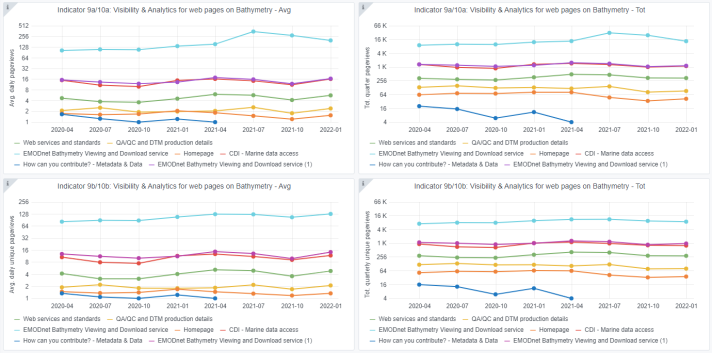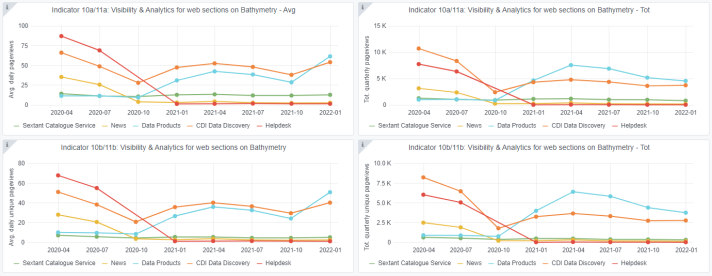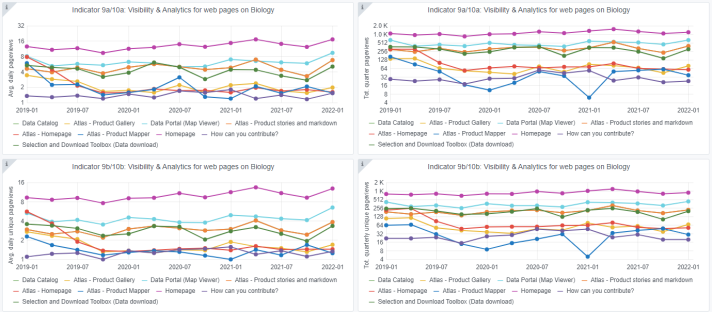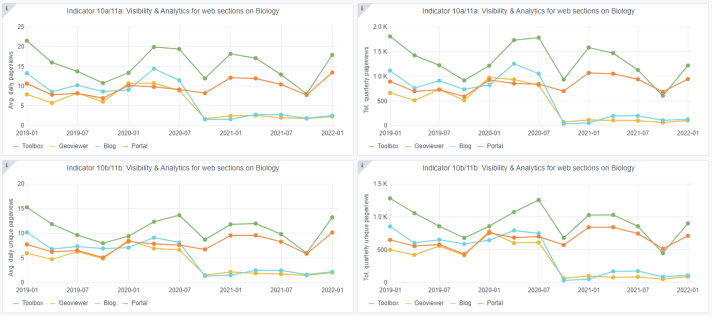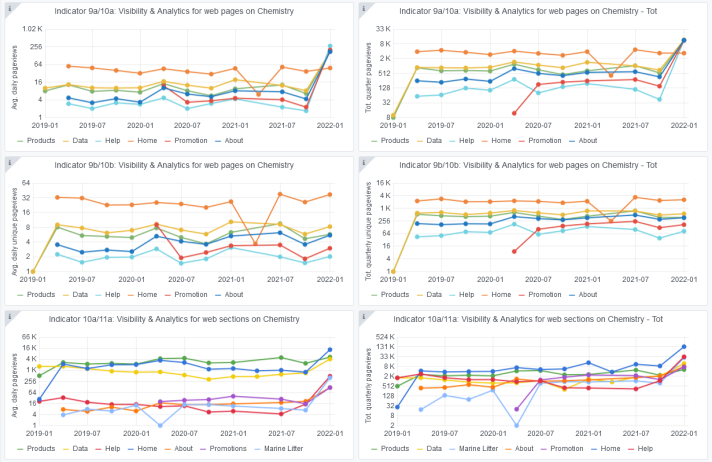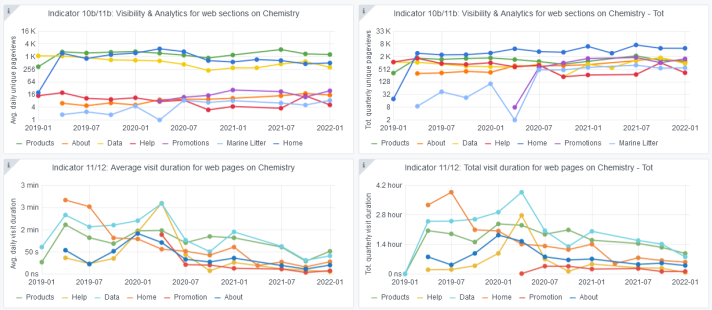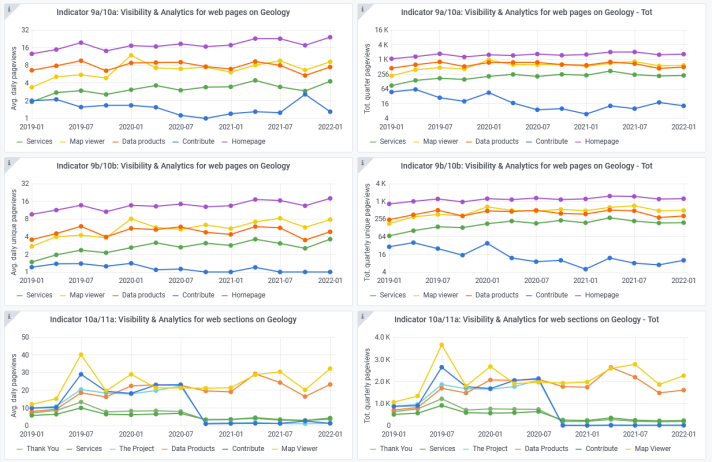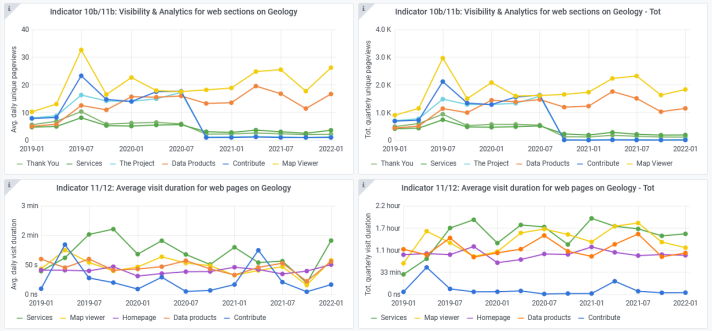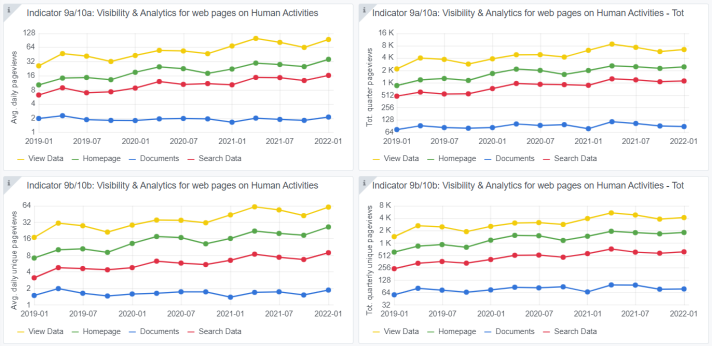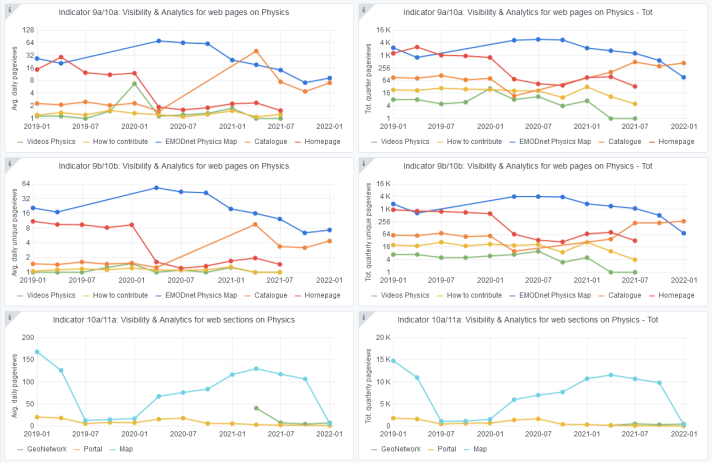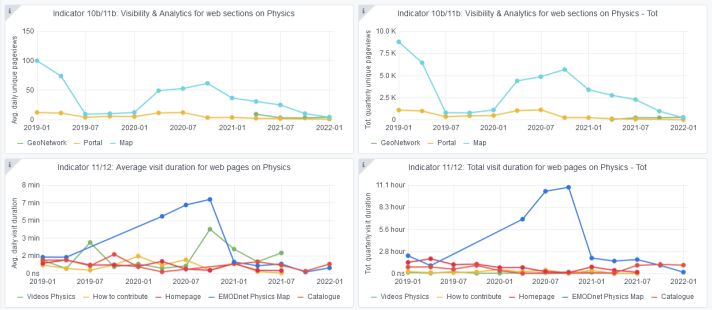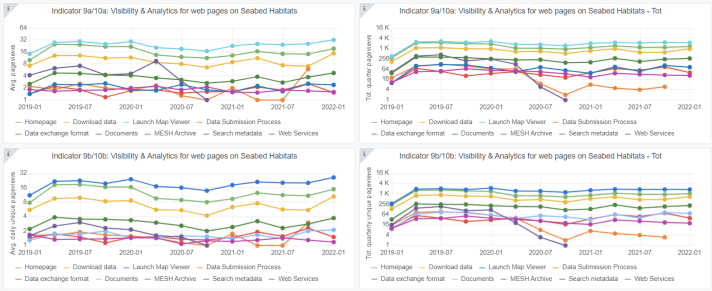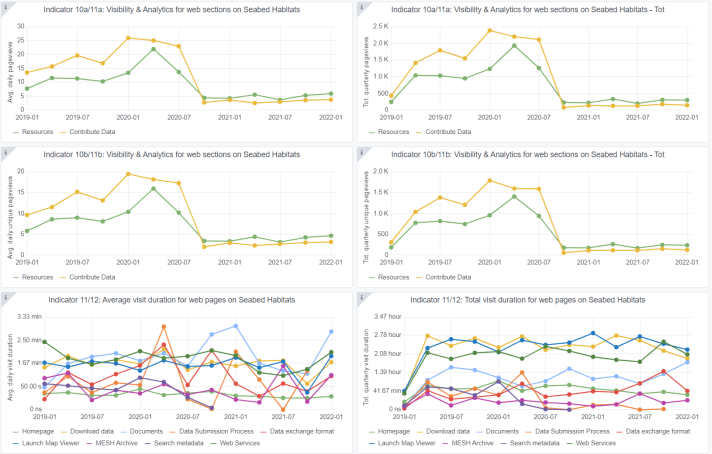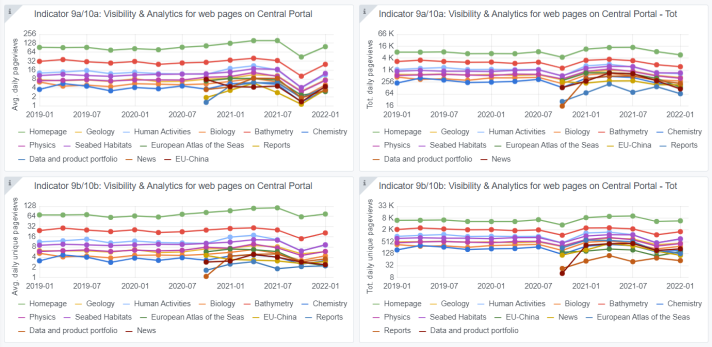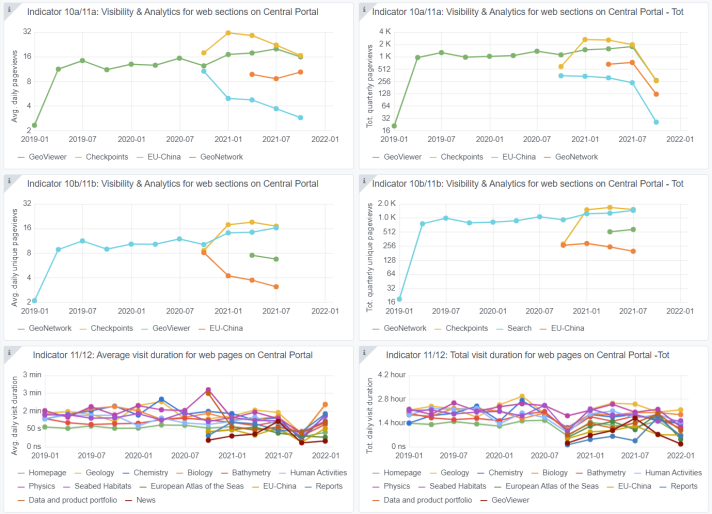EMODnet progress overview
Common progress highlights
This progress update covers the last quarter of 2021, marking the end of a four-year EMODnet Secretariat work cycle and the beginning of a new two- to four-year work plan.
This year’s Ocean Hackathon®, organised by the Campus Mondial de la Mer, was the first edition where EMODnet took on the role of Ambassador. During the 48 hours non-stop weekend (5-7 November 2021), teams, spread over 14 cities world-wide, were working on developing prototypes using various digital data related to the seas and oceans. EMODnet contributed by coaching and providing technical advice on EMODnet’s data, data products and services. At the end of the weekend, the winning teams of the 14 cities were invited to pitch their project in 5 minutes at the Grand Finale happening in Brest on the 15th of December. EMODnet Secretariat was a member of the jury of the Grand Finale.
The EMODnet network welcomed associated partners Cerema (Centre for Studies and Expertise on Risks, the Environment, Mobility and Urban Planning) and develogic GmbH subsea systems.
The report of the EMODnet Conference 2021 is now available for download. It includes short summaries from the EMODnet Jamboree workshops (16-18 June 2021 and the EC Ocean Observation event (18 June 2021). You can also relive the moment by watching the short Conference video.
Specific progress and achievements of the thematic data assembly groups
- New contributions from 16 data providers resulted in an increase in the number of EMODnet Bathymetry survey datasets from 31,097 to 31,432. There are regular contacts between the Central Portal technical team and EMODnet Bathymetry to advance the discussions and work on the centralisation of the data, products, and services. For example, it is planned that the new central portal map viewer will take over the functionality of the EMODnet Bathymetry Viewing and Downloading service to facilitate selection and downloading of EMODnet DTM tiles and High-Resolution DTMs. The products will also be included in the new central EMODnet Data Products catalogue.
- The new data harvest in October added 39 new datasets to EMODnet Biology and resulted in the update of one existing dataset. Now, there is a total of 26.6 million occurrence records available. A new collaborative relationship between the University of Liège and the Marine Biological Association (MBA) will result in the improvement of the quality of the thematic lot’s maps of zooplankton distributions in time and space. Considerable progress has been made on the development of the EMODnetWFS (WFS = web feature service) package, for accessing data across thematic lots, which is foundational to ongoing development of products.
- The consortium of EMODnet Chemistry started on their new work plan for the centralization phase in October 2021. They organised an online training session (25-29 October) with all EMODnet’s data centers to reactivate data population and introduce new guidelines. Chemistry also improved their products’ description in the portal’s catalogue. Web content wise, they extended their “About” section by adding a new guideline, a new report, project meetings, eight pieces of news, six presentations and five publications. They maintained their support to the regional seas conventions, among others by supplying (marine) litter data and data products.
- EMODnet Geology started on its new work plan of the thematic node during this final quarter of 2021. They initiated work on the identification of new data and are, now, in the process of collecting them. During this quarter, four partners (A.P. Karpinsky Russian Geological Research Institute, Geological Survey of Ireland, Norges Geologiske Undersøkelse and the Geological Survey of Cyprus) submitted new datasets for “Submerged landscapes” (WP8) and two partners (British Geological Survey, and the Geological Survey of Finland) updated their data.
- EMODnet Human Activities updated a few datasets, including among others Aggregate extraction, Fish catches and Port traffic. Regarding the Shellfish dataset, new data for Spain and Slovenia have been processed. The Associazione Piscicoltori Italiani has accepted to provide EMODnet with aquaculture data on Italian farm locations. A meeting was held with the Italian institute that is developing Italy’s MSP.
- Four products have been updated and published by EMODnet Physics this quarter: one salinity product (EP_MAP_PSAL_006), one temperature product (EP_MAP_TEMP_005), one carbon dioxide product (EP_MAP_TCO2_001) and 1 pH product (EP_MAP_ALKY_001). The ingestion and inclusion into EMODnet Physics of the ARICE and EUROFleets+ data is still ongoing work.
- All consortium members of the EMODnet Seabed Habitats thematic lot have begun work to format and gather data. In phase IV, new data themes will be included such as coastal wetlands and essential fish habitats, for which the respective project partners have started the necessary work (such as development of standard vocabularies and identification of new datasets). A new composite data product was developed to help OSPAR for their assessment of the extent of physical damage to the seabed. The product combines individual habitat maps from surveys with EUSeaMap, to create a full-coverage data product for the northeast Atlantic showing the best available data.
EMODnet data portals usage
User visit statistics
User statistics (i.e. number of ‘unique’ page views and average visit duration) are collected through an EMODnet Matomo instance managed by VLIZ and is automated for the following progress/monitoring indicators: Visibility & Analytics for web pages; Visibility & Analytics for web sections; and Average visit duration for web pages (note that Matomo will gradually be replaced by ‘Europa Analytics’ as thematic portals are integrated into the Central Portal). The resulting graphs for each EMODnet thematic lot as well as the Central Portal can be viewed in the gallery at the end of this report. Unless stated otherwise, page views are average per day and trends are compared to the previous quarter.
- The number of pageviews remain stable from quarter to quarter for the various EMODnet Bathymetry webpages. Despite a slight decrease, EMODnet Bathymetry Viewing and Downloading service remains the most visited webpage (198 page views, compared to 274 previous quarter). Concerning visit duration, a daily average of 1.5 minutes was recorded for the EMODnet Bathymetry Viewing and download service, the webpage on web services and standards, and the webpage on QA/QC and DTM production details. This is line with figures from the previous quarter for the first two pages, and a significant increase for the latter page.
- Compared with the previous quarter, slight increases were observed in the number of page views for different EMODnet Biology webpages. Apart from the Homepage, the Map Viewer is the most viewed webpage (average of 9.5 page views, compared to 5.8 in the previous quarter). In this reporting period, users spent on average 2.3 minutes on the Atlas Product Gallery. The Atlas Product Mapper was less popular, with less average page views (1.5) and shorter average visit duration (12.5 seconds)
- Globally, EMODnet Chemistry, had a traffic increase for all web pages and more especially for the help page (from 2 to 271 average daily page views). The second most viewed section is the “Promotion” section with, on average, 197 daily page views. Users spent on daily average, between 6 (Help) and 52 seconds on the portal (Products).
- EMODnet Geology recorded an increase, in terms of page views, for all pages except the “Contribution” page (from 3, last quarter, to 1 this quarter). The most visited page was the Homepage with an average of 24 daily page views, followed by the “Map viewer” with an average of 9 daily page views. The portal pages are averaging on approximatively 1 minute per page view and 1 hour average per visit. Time spent on the pages by the users ranged from 17 seconds (Contribute page) to 1.5 minutes (Services). The previous remarked upon trend continues as the users are keener to accessing maps and downloads directly.
- Increasing trends were observed for EMODnet Human Activities’ Homepage (25 to 36) and View data page (64 to 95). On average, users spent between 30 seconds (Homepage) and 1.6 minutes (View data) on the portal.
- Both the map viewer and catalogue of EMODnet Physics recorded an increase, this quarter, in the average daily page views. The catalogue went from 4 to 7 daily page views. The map viewer average daily visit increased from 7 to 9 this quarter. Time spent on the portal by users ranged from 32 seconds (map viewer) up to 54 seconds (Catalogue).
- Overall, page views remained consistent for EMODnet Seabed Habitats compared to the previous quarter, apart from small increases for the webpages Launch Map Viewer, Homepage and Download data (average page views recorded between 15 and 32). The average time spent on the webpages increased for all webpages. Most time was spent on the Documents webpage, followed by Web services (between 2.8 minutes and 2.1 minutes respectively). Least time is spent on the Homepage, with about 289 seconds
Statistics on usage of EMODnet portals[1]
- Number of data downloads[2]:
- During the reporting period, 31 users downloaded 461 CDIs (Common Data Index) from the EMODnet Bathymetry portal, compared to the 348 CDIs downloaded last quarter.
- Compared to the previous quarter, there was an increase in the number of manual download requests on the EMODnet Biology portal, from 100 to 328.
- The number of requests for CDIs decreased slightly (from 39,536 to 33,561) for EMODnet Chemistry. The number of users (16) is the same as previous quarter.
- Compared to the summer period, the data download statistics increased for the vast majority of the EMODnet Human Activities sub-themes/datasets. Among the most downloaded datasets are Cables and Natura 2000 areas (respectively 148 and 160 downloads). Increasing as well as decreasing trends were observed in the number of WMS (Web Mapping Services) and WFS (Web Feature Service) requests.
- Data download trends on EMODnet Physics registered a decrease of download for most of the data. Except three datasets that registered a high and significant increase in download this quarter, namely Waves (from 339 up to 1,349 downloads this quarter, +298%), Winds (from 243 up to 1,504 downloads this quarter, +519%), and Ice coverage (from 2 to 35 downloads this quarter, +1,650%).
- A considerable increase of 51% was reported in the number of downloaded records for EMODnet Seabed Habitats, from 18,084,227 records to 27,389,692. Similarly, the number of WFS and WMS requests increased by 14 and 75% respectively.
- Number of data product downloads[3]:
- 15.620 DTM (Digital Terrain Model) tiles were downloaded from the EMODnet Bathymetry portal, which is more than double the tiles downloaded in the previous quarter (6,832 DTM tiles). 588 HR-DTMs (High Resolution Digital Terrain Model) were downloaded, compared to 547 in the previous quarter.
- EMODnet Biology recorded no change in the number of data product download requests this quarter (there were 2 downloads).
- EMODnet Chemistry saw a significant increase in map visualisations, especially the “silicates” product (increase of 533% compared to previous quarter). For the manual downloads there is globally a slight increase (on average 30% increase), except for the "contaminants" and the “fertilisers”.
- EMODnet Geology recorded a slight increase in usage per quarter, except for a dip in December. For most products, there was an increase in the manually download trends (up to 63% for the “Events and probabilities” product).
- Compared to the previous quarter, the EMODnet Human Activities Vessel Density maps were downloaded 1,684 times representing a 22% increase. The Route Density maps were downloaded less frequently compared to the previous quarter; 375 times compared to 400.
- EMODnet Physics recorded an increase, this quarter, on the map viewer for all its data products. The most viewed product on the map viewer, this quarter, was the “Temperature in the water column” (from 205 up to 314 views this quarter, +35% of interest). The “Currents” data product was, the one registering the highest increase of interest on the map viewer (+52%).
- Increases in dataset downloads were recorded by EMODnet Seabed Habitats. The most downloaded datasets were those related to EUSeaMap and composite data products (from 573 downloads in previous quarter to 1,357 downloads) and Individual habitat maps from surveys (from 59,170 to 96,411 downloads).
Recent meetings and events
Due to the CoViD-19 pandemic, most meetings and events in the fourth quarter of 2021 continued to be organised online and/or attended remotely. A few key meetings included the following:
- EMODnet Bathymetry attended the GEBCO Seabed 2030 Map the Gaps Symposium (30 November – 3 December) and joined a meeting with the IHO (International Hydrographic Organization) Europe Network Working Group (8-9 December).
- EMODnet Biology attended “4Oceans Project Workshop” (8 October) exploring the availability and use of historic data, and the Hack4Oceans hackathon (20-21 November) to provide support to participants.
- EMODnet Chemistry organised two internal meetings and they attended nine others. They attended the IODE training on “Implementing the Ocean Data and information System (ODIS) architecture (25-29 October), ICES WGML (Working Group on Marine Litter) meetings (12 November & 21 December), the Virtual exhibition ‘One Integrated Marine Debris Observing System (IMDOS) for a Clean Ocean (17-19 November), the “EUROSEA macroalgal workshop” (23-25 November) and some others also.
- EMODnet Geology (co-)organised eight meetings this quarter and attended three other ones. They attended the “Baltic Sea Science Congress” (18-22 October), the EMSAGG (European Marine Sand and Gravel Group) webinar on "Marine resource mapping in the UK and Europe” (18 November), and finally also the “30th International Cartographic Conference” (14-18 December).
- EMODnet Human Activities joined the Technical Expert Group of Marine Spatial Planning at European level (23 November) and organised an internal workshop on EMODnet Human Activities’ single model proposal (18 October and 19 November).
- EMODnet Physics co-organised 2 meetings and attended 21 others this quarter. They attended the “Blue Planet Forum” online event (8 October), the “AtlantOS Ocean Hour – All-Atlantic Ocean Data Space” (12 October) and the “TG (Technical Group) NOISE” (26 October).
- EMODnet Seabed Habitats attended the “Conference on Climate Change in the Caspian Sea Region” (27-28 October) and participated in the workshop “Towards a Coordinated European Observing System for Marine Macroalgae” (23 November).
Upcoming EMODnet meetings and events
The main EMODnet meetings planned for the coming period in 2022 are:
- One-on-One meetings between the Central Portal team and each of the thematic lots of EMODnet to explain, plan and move forward with the Centralisation process of EMODnet.
- The EMODnet partnership will be well represented at the IODE International Ocean Data Conference (14-16 February 2022), organised by IOC/UNESCO and held in Sopot (Poland). Many of the thematic lots will be presenting.
- EMODnet will be present at the Copernicus Marine Service 2021-2028 Kick-off event.
More information
More information about EMODnet’s resources is available at the following links:
- EMODnet Data and Data product portfolio: https://emodnet.ec.europa.eu/en/data-portfolio
- EMODnet for Business brochure: https://emodnet.ec.europa.eu/en/emodnet-business-brochure
Thematic portals
- EMODnet Bathymetry - www.emodnet-bathymetry.eu
- EMODnet Geology - www.emodnet-geology.eu
- EMODnet Seabed habitats - www.emodnet-seabedhabitats.eu
- EMODnet Physics - www.emodnet-physics.eu
- EMODnet Chemistry - www.emodnet-chemistry.eu
- EMODnet Biology - www.emodnet-biology.eu
- EMODnet Human Activities - www.emodnet-humanactivities.eu
Data Ingestion Service
- Ingestion and safe-keeping of marine data - www.emodnet-ingestion.eu
Sea-basin Checkpoint portals
For an overview of and access to information and outputs from each of the Sea-basin Checkpoints (projects ended), visit: https://emodnet.ec.europa.eu/en/checkpoints
- North Sea checkpoint - https://emodnet.ec.europa.eu/en/checkpoint/north-sea
- Mediterranean checkpoint - https://emodnet.ec.europa.eu/en/checkpoint/medsea
- Artic checkpoint - https://emodnet.ec.europa.eu/en/checkpoint/arctic
- Atlantic checkpoint - https://emodnet.ec.europa.eu/en/checkpoint/atlantic
- Baltic checkpoint - https://emodnet.ec.europa.eu/en/checkpoint/baltic
- Black Sea checkpoint - https://emodnet.ec.europa.eu/en/checkpoint/black-sea

